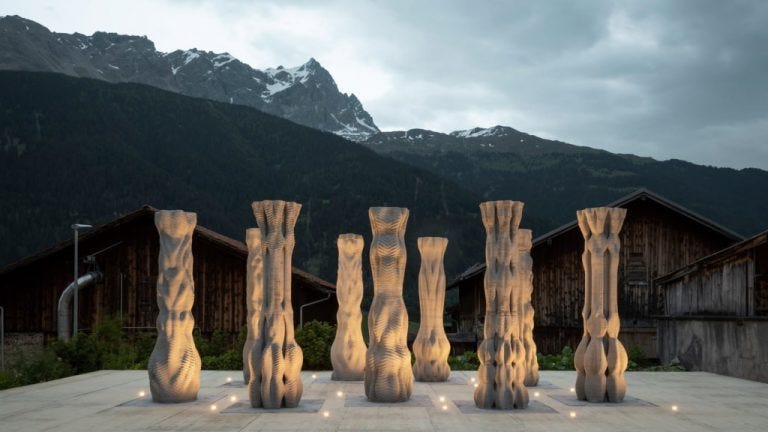Beauty, at last, is scalable
What AI and 3D printing mean for the future of joy, design, and everything we build.
There’s always been a tension between AI and creativity. Some people say it’ll never be as imaginative as a person. Others, in the advertising world for instance, get jittery, worried it’ll either replace them or make them redundant.
But today, I’d like to point to one domain where AI might actually bring more joy and pleasantness into the world. Architecture and design.
If we want it to, AI could finally help us escape the tyranny of the straight-lined, box-ticking, spreadsheet-justified design that’s been marketed to us as progress. You know the type, buildings that feel like they were grown in Excel, furniture that was mainly made because it could be machined and flatpacked.
Back when we still cared about pillars, we carved them into permanence. A pillar was more than just a load-bearing lump of concrete. It was a gesture. A flourish. A small nod to the people who’d come after us. Our kids, our grandkids. The pillar said: I was here. I cared.
Now? More often than now we just plop something in place that technically does the job. No more. No less. The math checks out. The spreadsheet says yes. A pillar is now a cost center. A procurement line item.
I’ve written before about my issues with modernism. About how Corbusier’s dream of the house as a machine helped ignite this whole clinical detachment. That thinking still echoes in concrete stairwells. And let’s not forget Adolf Loos, the Viennese prophet of minimalism, who thought ornament was a crime. "The ornament is wasted labor and hence wasted health," he said. But something’s shifting. Those words might no longer be true. AI and 3D printing might be the glitch in the blueprint.
What if we could ask a machine to design and print something beautiful? What if we could generate a thousand versions of a staircase or table leg or bridge support, all structurally sound, all mathematically valid and then choose the one that whispers something to the soul? We’re entering an era where beauty is no longer optional. It’s just an ask.
The Netherlands and Switzerland leading the way here. Amsterdam had the world’s first 3D-printed bridge, and now there are entire houses emerging from the printer nozzle. Walls that curve and fold like claymation. Concrete laid in soft, strange waves. Structures that feel grown instead of engineered. Same with furniture, latticed chairs and flowing tables that resemble coral reefs or spinal cords. They’re comfy. Solid. Sustainable.
Forget for a moment my nostalgia for the old grandeur. This is simple refusal. It’s a refusal to accept sterility as a side effect of engineering. A resistance against the bland tyranny of usefulness. Suddenly, weirdness and meaning are viable specs. The tools we’re building include AI, 3D printers, and parametric design engines. They make it easy. It used to be that beauty cost more. Now, it’s just a different equation. And cost will have nothing to do with it. So maybe finally, we can start scaling beauty again. Prompt some printable rococo.
I want strangeness. Not sterile chairs with product codes, but carved pillars that double as AI dreams. Storytelling furniture. Coat racks shaped like nervous systems. And thanks to this strange new moment, where creativity can be printed, we might just get it.
I know people want this. I live in the country where the evidence is built right into the skyline. Belgium, for all its brutalist sins, has always excelled at accidental expressionism. We stack Spanish villa roof tiles on neoclassical façades and wrap the whole thing in PVC siding. It’s like AI had a nervous breakdown mid-render. That chaos, the so-called "ugly Belgian house", is also a kind of freedom. Imagine what we could do if we handed that same chaotic personal expression a proper toolset. Imagine the ugly Belgian house, but on purpose. And beautiful.
Picture a street in castle towers, Tuscan balconies, modernist cubes all mingling like an odd harmony that somehow works.
And if we let it, the next generation of pillars might be worth looking at again. Not just standing under. Maybe they will say: we cared and we enjoyed ourselves.
Perhaps we’ll even get to answer that quiet, growing hunger for maximalism. Not as a luxury trend. But as something everyone can tap into. A shared weirdness. A beautiful, generative mistake we get to keep in a new era of expression, after a century of sensible but boring modernisms.






